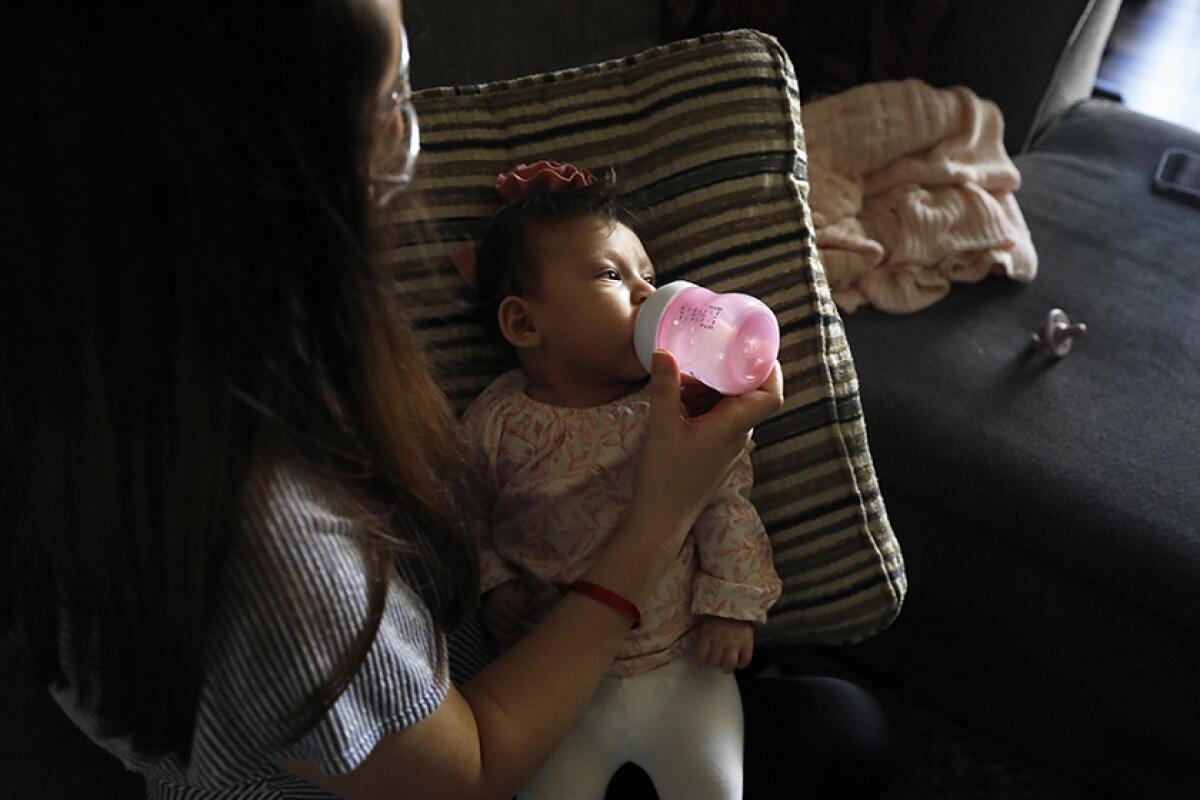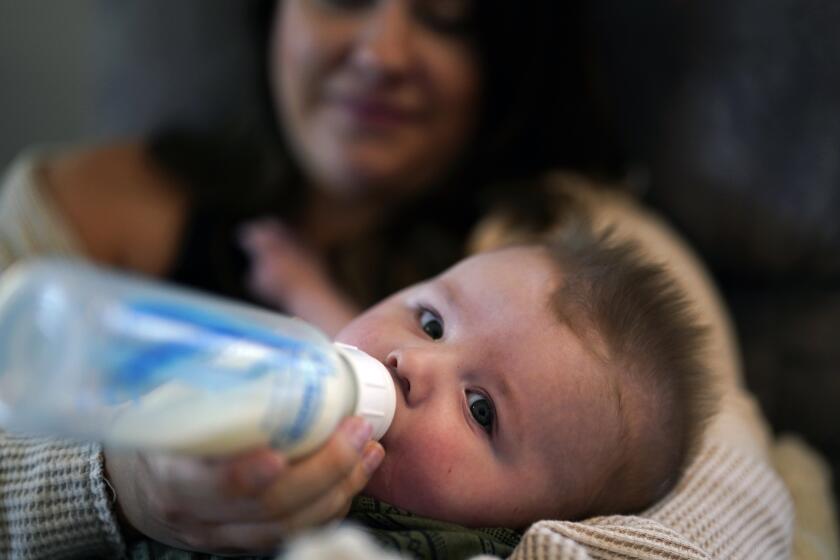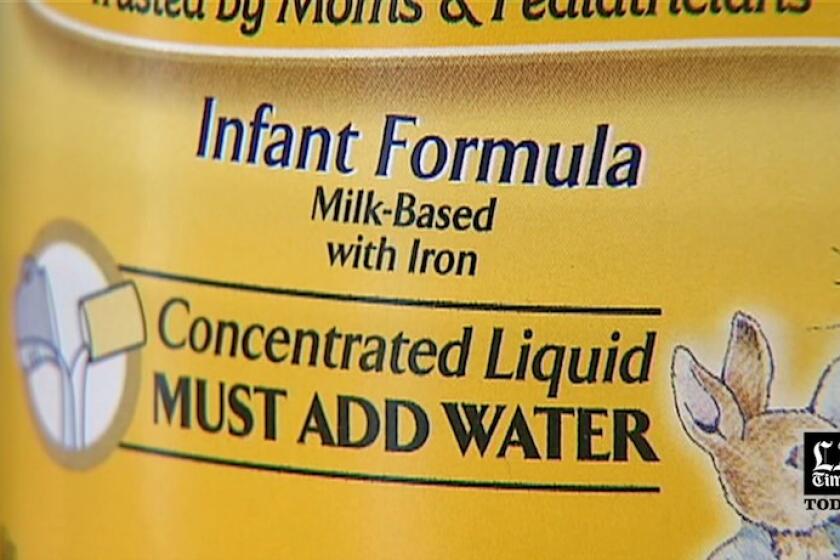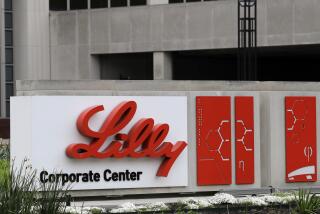Editorial: The shame of America’s baby-formula shortage

- Share via
When the sudden COVID-19 shutdown caused people to hoard toilet paper, the nation was half amused by the inability to find a roll on any retail shelf.
There’s nothing funny, though, about the baby-formula shortage that has reached a peak in recent weeks. Many babies need formula to survive and thrive. It contains all the nutrients, in the right quantities, to meet an infant’s health and developmental needs. Some parents have reportedly taken to watering down commercial formula, a dangerous step that threatens to leave their babies malnourished. And pediatricians are warning parents against making homemade formula.
The scarcity should be easing, now that the U.S. Food and Drug Administration is allowing the import of more brands of European formula and has reached an agreement with Abbott, the country’s biggest formula maker, to restart production at its Michigan plant. But it could be two months before the facility is fully operational. The plant was closed in February after a contamination of a deadly bacteria was found. Several babies who were drinking the formula got sick and two died, though the company says there is no evidence that its product was the cause.
The plant could reopen within two weeks once the consent decree is approved. Product would be on the shelves in six to eight weeks after.
President Biden announced Wednesday that he is invoking the Defense Production Act to overcome the supply chain problems by directing suppliers to give formula producers priority on the delivery of key ingredients.
Like many other products, infant formula has been in short supply since the early months of the pandemic, caused by “supply chain problems.” It’s not known exactly which part of the chain is involved, except by the formula manufacturers, said Dr. Steven Abrams, a professor of pediatrics and nutrition science at the University of Texas at Austin, who has been tracking the issue.
The shortage was manageable, though, until Abbott Nutrition recalled some of its products and then extended the shutdown to all of its lines of formula at the largest plant in the nation. Certainly, public health officials should have foreseen that any significant wobble in this market could create a serious shortfall because three companies produce most of the supply. Preventing the shortage would have been much simpler than fixing it.
Federal action took far too long. Only over the last week has the FDA acted in any serious way. The federal government should have been purchasing stock from Europe and Mexico, another source of formula that meets U.S. standards, as soon as the Abbott plant was shuttered, and invoked the Defense Production Act earlier.
What makes the situation especially upsetting is that low-income mothers and their babies were put in an untenable position. The federal Women, Infants and Children nutrition program for families in need, which among other things provides free infant formula for impoverished families, has agreements with formula makers who provide their product at no cost; in exchange, the companies get free marketing and greater shelf space in stores.
Under those agreements, though, mothers in any given state’s WIC program are limited to a single brand of formula. So while other families could buy expensive specialty formula or choose a store brand, at least when those were available, WIC mothers were left with no options when their stores ran out of the program-approved brand. (Exceptions were made in states that contracted with Abbott, but with a generalized shortage like this, all mothers needed the freedom to purchase whatever formula they could find.) This isn’t a minor issue; about half the formula in this nation is obtained through the WIC program.
This has been yet one more sad example of how the nation puts an unacceptably low priority on the health and welfare of mothers and babies — from failure to guarantee paid maternity leave for workers to lack of child-care support — which affects the choices new mothers are forced to make. So it’s not a surprise that this nation has among the lowest rates of breastfeeding in the developed world. Though breast milk is known to be the healthiest form of nutrition for young babies, many working mothers simply don’t have the support needed to breastfeed and pump while trying to hold down a job.
There’s still work to be done on the formula front. The reason European formula has largely been blocked from U.S. shelves isn’t safety or wholesomeness; it’s an FDA labeling issue, Abrams said. This is the kind of regulatory protectionism that has kept American consumers from having more products to choose from and that has prevented more competition in the marketplace. WIC families also need more choice in the products they buy, even if that means the federal government will need to provide subsidies instead of relying on free products from the formula manufacturers. And, according to an article published Tuesday in the American Journal of Clinical Nutrition, the federal government must take action to encourage the establishment of more manufacturers of formula in this country so that infant nutrition isn’t so reliant on a single plant.
But the best choice would be for mothers to be able to breastfeed their babies through better maternal leave and childcare available at their work sites so they could nurse during breaks. Other nations are showing the way. The question is whether the U.S. will ever be as much about family values as it likes to say it is.
More to Read
A cure for the common opinion
Get thought-provoking perspectives with our weekly newsletter.
You may occasionally receive promotional content from the Los Angeles Times.












